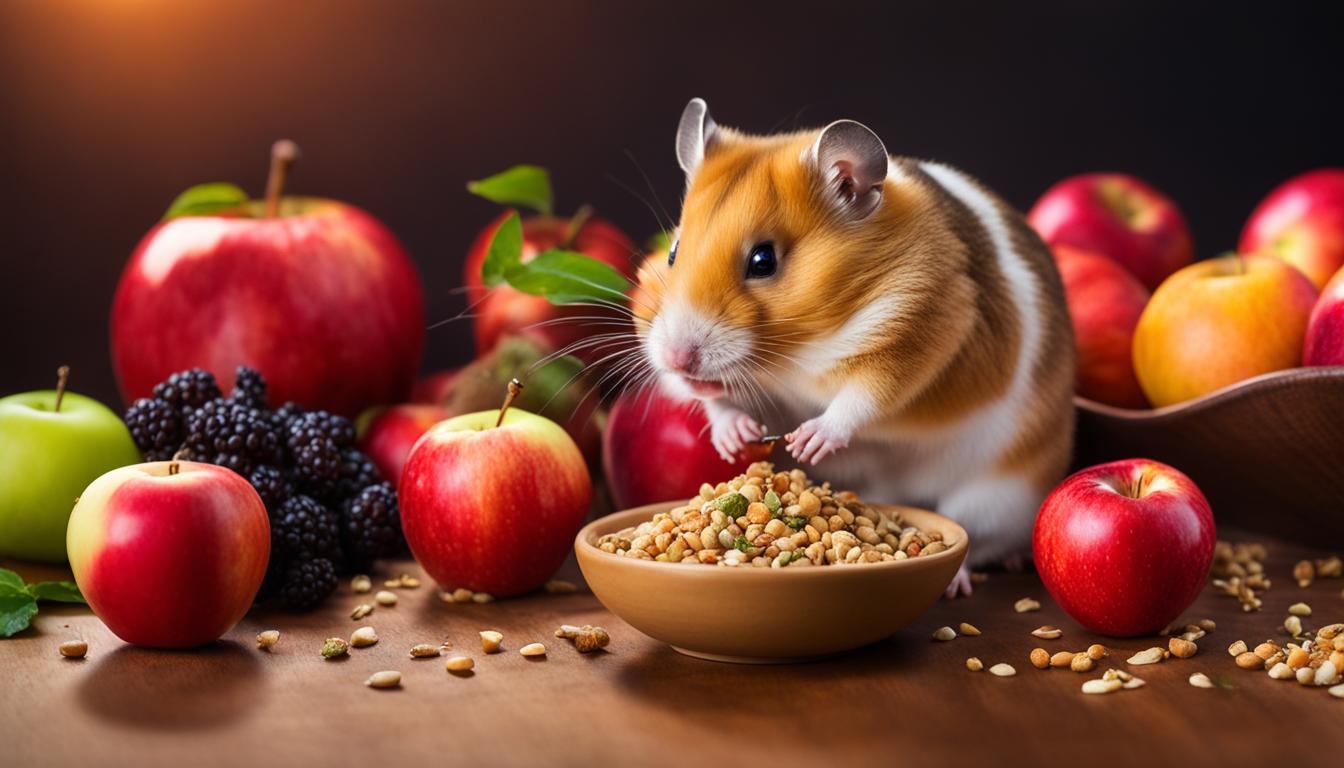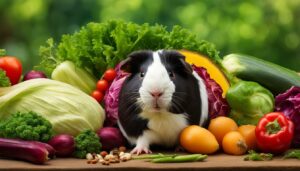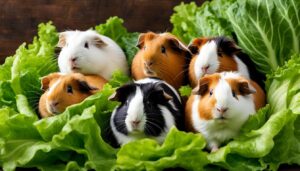Are you wondering if your furry little friend can enjoy a sweet treat like apples? In this guide, we’ll explore the world of hamster diets and answer the question: Can hamsters eat apples? Let’s dive in!
Key Takeaways:
- Hamsters can eat apples in moderation as part of a balanced diet.
- Apples are a good source of vitamins and antioxidants for hamsters.
- Remember to remove the seeds and peel the apple before feeding it to your hamster.
- Limit the portion size to a quarter teaspoon once or twice a week to avoid obesity and diabetes.
- Apples can be a healthy and enjoyable snack for your furry friend when given as an occasional treat.
Health Benefits of Apples for Hamsters
Apples offer several health benefits for your hamster. They are a great source of vitamin C, which supports their immune system and promotes healthy skin. Additionally, apples contain antioxidants that help prevent diseases and promote overall well-being. The fiber found in apples aids in digestion and helps prevent constipation, keeping your hamster’s digestive system healthy. While apples should be given in moderation due to their sugar content, they can be a healthy and tasty addition to your hamster’s diet when offered as an occasional treat.
Health Benefits of Apples for Hamsters
| Nutrient | Health Benefit |
|---|---|
| Vitamin C | Supports immune system and skin health |
| Antioxidants | Help prevent diseases and promote overall well-being |
| Fiber | Aids in digestion and prevents constipation |
When feeding apples to your hamster, make sure to remove the seeds to prevent choking. It’s also important to wash the apple thoroughly before feeding it to remove any pesticides. Including the skin of the apple can provide additional nutritional benefits, as it contains insoluble fiber that aids in digestion. Remember to offer apples in moderation, as excessive sugar consumption can lead to obesity and diabetes in hamsters. With proper portion control, apples can be a healthy and enjoyable snack for your furry friend.
In addition to apples, there are other safe and healthy treats you can offer your hamster. Strawberries, bananas, and watermelons are all suitable fruits that can be given in small portions. Vegetables like carrots, broccoli, and spinach are also great options for hamster treats. It’s important to introduce new foods gradually and monitor your hamster’s reaction to ensure they tolerate them well. If you’re ever unsure about feeding your hamster a particular food, consult with a veterinarian for guidance.
Apples for Dwarf Hamsters
Dwarf hamsters, including Campbell’s and Roborovski hamsters, can enjoy apples as part of their diet, but it’s important to be mindful of their consumption. These small hamster breeds have a higher risk of developing diabetes, so it’s crucial to limit their intake of sugary foods like apples.
When feeding apples to dwarf hamsters, it’s best to provide minimal amounts as an occasional treat. This helps maintain their overall health and reduces the risk of diabetes. Remember to remove the seeds and peel the apple before offering it to your dwarf hamster, as the seeds can pose a choking hazard and the peel may contain pesticides.
By offering a small piece of apple as a special treat once in a while, you can provide your dwarf hamster with a tasty and enriching snack without compromising their well-being.
| Dwarf Hamsters and Apples | Feeding Recommendations |
|---|---|
| Can dwarf hamsters eat apples? | Yes, but in small quantities |
| Why should apple consumption be limited for dwarf hamsters? | Higher risk of diabetes |
| What precautions should be taken when feeding apples to dwarf hamsters? | Remove seeds and peel the apple |
| How often should dwarf hamsters be given apples? | As an occasional treat |
Dwarf Hamsters and Apples
- Apples can be enjoyed by dwarf hamsters but should be given in small quantities to prevent health issues.
- Remove seeds and peel the apple before feeding to reduce choking hazards and pesticide exposure.
- Limit apple treats to an occasional offering to help maintain your dwarf hamster’s overall health.
It’s important to prioritize the well-being of your dwarf hamster by providing them with a balanced diet and considering their specific dietary needs. While apples can be a delightful treat, moderation is key to ensure their health and happiness.
Feeding Apples with Skins
Hamsters can safely eat apples with the skin on, as long as certain precautions are taken. It is important to remove the seeds from the apple before feeding it to your hamster, as they can be a choking hazard. Additionally, it is recommended to wash the apple thoroughly to remove any pesticides that may be present on the skin. The apple skin itself contains insoluble fiber, which can aid in digestion for your hamster. By including the skin along with the flesh, you can provide additional nutritional benefits to your furry friend.
If you choose to feed your hamster apples with the skin, remember to do so in moderation. Apples should not be the main component of their diet, but rather a treat to be given occasionally. It is important to maintain a balanced hamster diet that includes commercially available hamster food as the staple. Alongside the apple treats, ensure that your hamster has access to fresh water daily and avoid overfeeding on sugary fruits and treats to prevent obesity and other health issues.
In summary, feeding apples with skins to your hamster can be a healthy and enjoyable addition to their diet when done correctly. Remember to remove the seeds, wash the apple thoroughly, and limit the portion size to prevent any potential risks. By offering apples as a well-balanced treat along with other hamster-friendly foods, you can provide a varied and nutritious diet for your furry companion.
The Benefits of Feeding Apples with Skins to Hamsters
Feeding apples with skins to hamsters can provide several benefits for their overall health. The apple skin contains insoluble fiber, which aids in digestion and promotes a healthy digestive system in hamsters. The fiber content helps prevent constipation and keeps the digestive system functioning smoothly.
In addition to the fiber, apples also offer a range of vitamins and antioxidants that can support your hamster’s immune system and overall well-being. The skin of the apple contains essential nutrients that can contribute to your furry friend’s overall health and vitality.
Remember to introduce any new foods gradually and monitor your hamster’s reaction. If there are any signs of digestive upset or other adverse effects, discontinue feeding apples to your hamster and consult with a veterinarian.
| Benefits of Feeding Apples with Skins to Hamsters |
|---|
| Provides insoluble fiber for digestion |
| Supports immune system and overall well-being |
| Contains essential nutrients for hamsters |
Risks of Feeding Apples to Hamsters
While apples offer health benefits for hamsters, it’s important to be aware of the risks associated with feeding them to your furry friend. The high sugar content in apples can contribute to obesity and diabetes if consumed in excessive amounts. To prevent these health issues, it’s crucial to limit the portion size and frequency of apple treats in your hamster’s diet.
An additional risk with apples is the presence of seeds that contain a compound that can release cyanide when digested. Therefore, it’s essential to remove all seeds before feeding apples to your hamster to ensure their safety. This precaution will help protect your hamster from potential harm.
As with any new food introduced into your hamster’s diet, it’s recommended to observe their reaction carefully. If you notice any signs of digestive upset or adverse reactions, it’s best to discontinue feeding apples and consult with a veterinarian for further guidance.
Table: Risks of Feeding Apples to Hamsters
| Risks | Prevention |
|---|---|
| High sugar content | Limit portion size and frequency of apple treats |
| Potential cyanide release from seeds | Remove all apple seeds before feeding |
| Adverse reactions | Observe hamster’s response and consult a veterinarian if needed |
By being aware of the risks and taking the necessary precautions, you can still enjoy the benefits of apples as an occasional treat for your hamster without compromising their health and well-being.
Other Safe Treats for Hamsters
While apples can be a healthy treat for your hamster, it’s always good to have some variety in their diet. Here are some other safe and tasty treats you can offer to your furry friend:
1. Strawberries
Strawberries are a delicious and nutritious fruit that hamsters can enjoy in small portions. They are packed with vitamins and minerals, including vitamin C, which is important for their immune system. Make sure to wash the strawberries thoroughly before offering them to your hamster, and remove any stems or leaves. Cut the strawberries into small pieces to prevent choking.
2. Bananas
Bananas are another safe fruit that can be given to hamsters as a treat. They are a great source of potassium and provide energy to your little friend. You can offer small slices of banana to your hamster, making sure to remove the peel. It’s best to offer ripe bananas, as they are easier for your hamster to chew and digest.
3. Watermelons
Watermelons are a refreshing and hydrating treat for hamsters, especially during hot summer months. They contain a high water content and are rich in vitamins A and C. Remove the seeds and rind, and offer small, bite-sized pieces of watermelon to your hamster. Remember to wash the watermelon thoroughly to remove any dirt or pesticides.
Remember, when introducing new treats to your hamster, it’s important to do so gradually. Monitor your hamster’s reaction to ensure they tolerate the new foods well. Always consult with a veterinarian if you have any concerns about your hamster’s diet or health.
| Treat | Benefits | Precautions |
|---|---|---|
| Strawberries | High in vitamin C Nutritious and tasty |
Wash thoroughly Remove stems and leaves |
| Bananas | Good source of potassium Provides energy |
Remove peel Offer ripe bananas |
| Watermelons | Hydrating and refreshing Rich in vitamins A and C |
Remove seeds and rind Wash thoroughly |
Serving Suggestions for Apples
When it comes to serving apples to your hamster, there are a few ways to make it enjoyable and interesting for them. Here are some serving suggestions:
1. Chunks of Apple:
You can simply offer small chunks of apple as a standalone treat for your hamster. Make sure to remove the seeds and peel the apple if necessary, as the seeds can be a choking hazard. This allows your hamster to enjoy the natural flavor and texture of the apple.
2. Nutritious Shake:
An alternative is to blend apple with other hamster-friendly ingredients like banana, oats, and Greek yogurt to create a nutritious shake. This provides a tasty and balanced treat that your hamster will love. Be mindful of the portion size and frequency of these shakes to maintain a healthy diet.
3. Hamster Truffles:
If you’re feeling creative, you can even make hamster truffles using apple, dates, and nuts. Process these ingredients together into small balls and serve them as a special treat. This adds variety and excitement to your hamster’s snack time.
Remember to always monitor your hamster’s overall diet and treat consumption. While apples are a healthy option, they should be given in moderation as part of a balanced hamster diet.
| Treat Photo | Description |
|---|---|
 |
Chunks of apple served as a standalone treat. |
 |
Apple blended with banana, oats, and Greek yogurt to create a nutritious shake. |
 |
Hamster truffles made with apple, dates, and nuts. |
Tips for Introducing New Treats to Hamsters
When it comes to introducing new treats to your hamster, following a systematic approach is crucial. By taking the necessary precautions, you can ensure the safety and enjoyment of your furry friend. Here are some helpful tips to guide you:
- Start with freshness: Always ensure that the treat you are offering is fresh and free from any signs of spoilage. Fresh treats are not only more appealing to your hamster but also minimize the risk of digestive upset.
- Test a small piece: Before incorporating a new treat into your hamster’s diet, it’s wise to test a small piece first. Observe your hamster closely over the next few days for any signs of allergic reactions or digestive issues.
- Gradual introduction: If your hamster tolerates the treat well during the initial test period, you can gradually introduce it into their regular diet. Start by offering small portions at regular intervals to prevent overindulgence or potential stomach upset.
By following these steps, you can ensure that the new treat is safe, well-tolerated, and enjoyed by your hamster. Remember that each hamster may have individual preferences and sensitivities, so always monitor their reactions and consult with a veterinarian if you have any concerns.
Table: Safe Treats for Hamsters
| Treat | Description |
|---|---|
| Apples | A healthy and enjoyable treat when given in moderation, rich in vitamins and antioxidants. |
| Strawberries | Delicious and packed with vitamin C, strawberries are a safe occasional treat. |
| Bananas | High in potassium and easily digestible, bananas make a great occasional addition to your hamster’s diet. |
| Carrots | Crunchy and low in calories, carrots are a favorite among hamsters and provide essential vitamins. |
| Broccoli | A nutritious and fiber-rich treat that supports overall hamster health. |
Remember to offer these treats in moderation, alongside a balanced hamster diet, to keep your furry friend healthy and happy.
Importance of a Balanced Hamster Diet
A balanced diet is essential for the overall health and well-being of your hamster. Providing a variety of nutritious foods is key to ensuring they receive the necessary nutrients to thrive. Commercial hamster foods that are specifically formulated to meet their dietary requirements should be the foundation of their diet. Look for products that offer sufficient protein and are suitable for your hamster’s preferences.
The Role of Hamster Food
Hamster food provides a balanced mix of grains, seeds, nuts, and vegetables that are formulated to meet the nutritional needs of hamsters. These pellets or muesli mixes contain essential vitamins, minerals, and protein to support their growth, immune system, and overall health. It is important to choose high-quality hamster food that is fresh and not dusty, as stale or dusty food can lead to digestive issues.
Additionally, ensure that the hamster food is appropriate for your specific breed of hamster, as different breeds may have slightly different dietary requirements. Always consult with a veterinarian if you have any concerns or questions about your hamster’s food.
Supplementing with Fresh Foods
In addition to hamster food, fresh foods can be incorporated into your hamster’s diet to provide variety and additional nutrients. Fruits and vegetables that are safe for hamsters, such as apples, strawberries, carrots, and broccoli, can be offered in small portions as occasional treats. These fresh foods not only provide essential vitamins and minerals but also help to stimulate your hamster’s natural foraging instincts and keep them mentally stimulated.
It is important to introduce new foods gradually and monitor your hamster’s reaction. If your hamster shows any signs of digestive upset or discomfort, discontinue the new food and consult with a veterinarian. Remember to remove any uneaten fresh food from your hamster’s enclosure to prevent spoilage and bacterial growth.
| Key Components | Benefits |
|---|---|
| Protein | Supports muscle growth and repair |
| Fiber | Aids in digestion and prevents constipation |
| Vitamins and Minerals | Support overall health and immune function |
By offering a balanced diet consisting of high-quality hamster food and occasional fresh foods, you can ensure that your hamster receives the nutrition they need to lead a healthy and happy life. Remember to provide fresh water daily and monitor your hamster’s water intake to prevent dehydration. Avoid overfeeding on sugary fruits and treats to prevent obesity and other health issues. Your hamster’s diet is a crucial aspect of their care, and by prioritizing their nutritional needs, you can help them thrive for years to come.
Conclusion
In conclusion, when it comes to your hamster’s diet, apples can be a safe and nutritious option. While they provide health benefits such as vitamin C, antioxidants, and fiber, it’s important to feed them in moderation. Removing the seeds and peel is essential to prevent choking and pesticide exposure.
Remember to limit the portion size and frequency of apple treats to maintain a balanced hamster diet. By doing so, you can avoid potential health issues like obesity and diabetes. Offering a variety of safe foods alongside apples, such as strawberries, bananas, and vegetables, can add diversity to your hamster’s snack time.
As a responsible hamster owner, it’s crucial to prioritize your furry friend’s well-being. Providing commercial hamster foods that are nutritionally balanced, fresh water daily, and monitoring their water intake are key components of a healthy diet. By following these guidelines and incorporating apples as an occasional treat, you can ensure your hamster enjoys a balanced and fulfilling diet.
FAQ
Can hamsters eat apples?
Yes, hamsters can eat apples in moderation as a treat.
Are apples beneficial for hamsters?
Yes, apples are a good source of vitamins and antioxidants for hamsters.
Do hamsters need to have the seeds removed from apples?
Yes, it’s important to remove the seeds from apples to prevent choking.
Should the apple skin be removed before feeding it to hamsters?
No, the skin of the apple can be fed to hamsters as it contains insoluble fiber.
Are there any risks associated with feeding apples to hamsters?
Yes, apples have a high sugar content and can contribute to obesity and diabetes if given in excessive amounts.
What other treats can hamsters safely eat?
Hamsters can also enjoy strawberries, bananas, watermelons, carrots, broccoli, and spinach in small portions.
How can apples be served to hamsters?
Apples can be served as small chunks, blended with other ingredients, or made into hamster truffles.
What is the recommended approach for introducing new treats to hamsters?
It’s important to test a small piece of the treat first and gradually introduce it into the hamster’s diet if there are no negative reactions.
Is a balanced diet important for hamsters?
Yes, a balanced diet is crucial for hamsters’ overall health and well-being.
Are there any other tips for hamster diet and feeding?
Remove uneaten food, provide fresh water daily, and avoid overfeeding on sugary fruits and treats to prevent obesity.




